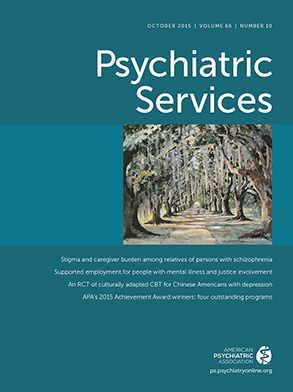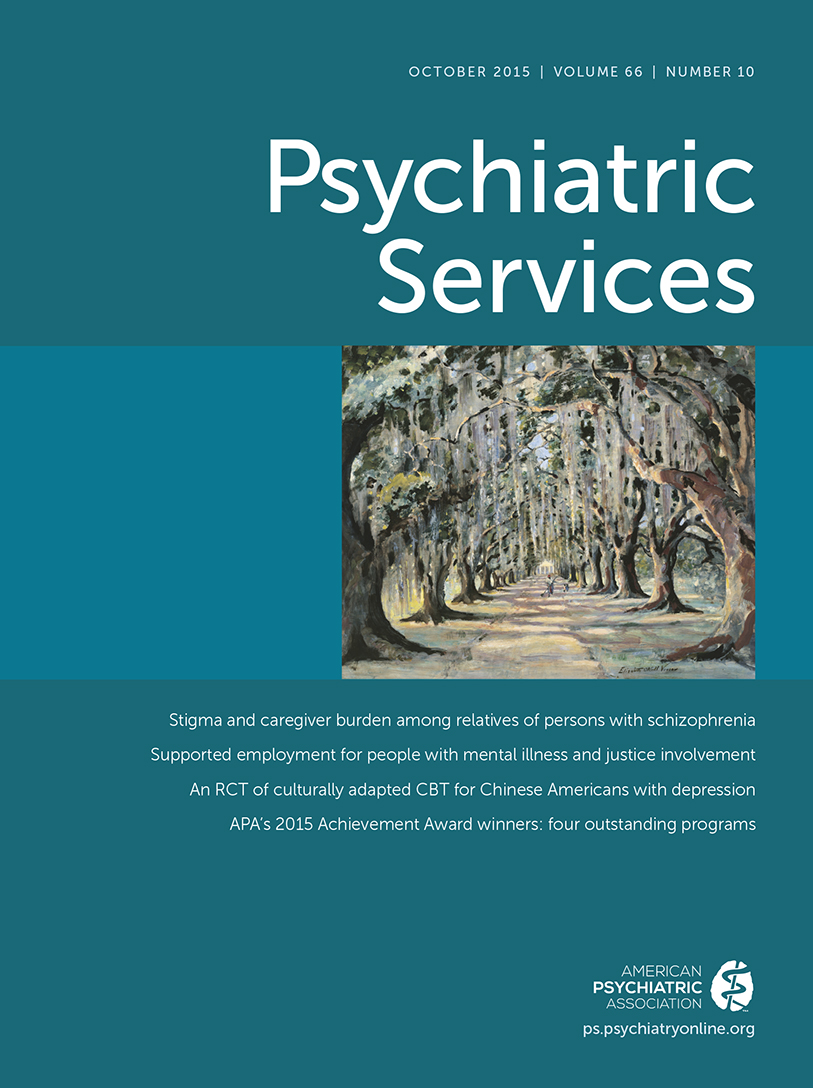National dialogue regarding coverage for mental health treatment has accompanied implementation of the Mental Health Parity and Addiction Equity Act (MHPAEA) and the Affordable Care Act (ACA) (
1,
2). The MHPAEA generally applies to public and private employers with >50 employees and requires that the financial requirements applied to mental health and substance use disorder benefits be “no more restrictive” than the financial requirements applied to medical and surgical benefits (
3). Under the ACA, new insurance policies offered through state exchanges and Medicaid must include ten essential benefits, including mental health and substance use disorder services (
4), which must also meet the parity criteria. These legislative acts have helped expand coverage of mental health services, which will likely mean that rates of treatment will continue to rise (
5). In addition to these policy initiatives, recent school and campus shootings, such as those in Virginia and Connecticut, have brought additional attention to the issue of access to mental health care, because the young men involved in the shootings are suspected to have had mental disorders. The perceived connection between mental illness and violence has lent further urgency to calls for improved access to mental health services.
As policy in this area has evolved, it is less clear to what extent public opinion has changed regarding required mental health coverage by insurance plans. In 1998,
Psychiatric Services published an extensive examination (
6) of public support for mental health coverage; the study drew from surveys conducted between 1989 and 1994. Depending on the survey and specific phrasing of the survey items, public support for mental health coverage was generally near 80%, whether phrased as support for mental health care in general or as a comparison to treatment for other medical illness. More recently, Barry and McGinty (
7) found that 69% of a national sample supported insurance parity for “mental health and drug and alcohol abuse services.” Less is known regarding the extent to which the public presently supports coverage for mental health care relative to other specific medical services. Smith and colleagues (
8) published analyses comparing public willingness to pay to avoid mental illness compared with general medical illness. While rating mental illnesses (depression and schizophrenia) as relatively more burdensome than general medical illnesses (diabetes, below-the-knee amputation, or partial blindness), respondents were willing to pay 40% less to avoid the mental illnesses, suggesting lower willingness to allocate resources for treatment of mental illness.
The ongoing course of ACA implementation highlights the importance of public support for policy. Since the legislation’s passing, the ACA has had a relatively low level of public support, with a larger share of respondents viewing it unfavorably than favorably in national polling (
9). This lack of a favorable public attitude has created an environment that has helped sustain political and judicial challenges to the legislation, which would likely be less common if the ACA had significant public support. Therefore, successful implementation of the MHPAEA and essential-benefit provisions of the ACA would benefit from robust public support.
As part of a national survey, factors associated with public support concerning the requirement that insurers provide coverage for a variety of medical services, including mental health care, were explored. Given that personal experience of mental illness is known to influence support (
10), we tested whether prior receipt of care would moderate the association of other characteristics with required support.
Methods
The sample (N=2,124) was from wave 20 of the C. S. Mott Children’s Hospital National Poll on Children’s Health (NPCH), fielded in November 2013. The survey population is drawn from the KnowledgePanel (GfK Custom Research North America), a nationally representative online panel established through probability sampling of the civilian, noninstitutionalized U.S. population aged ≥18 years. Unselected volunteers are not able to join the KnowledgePanel. Panel members are provided a computer and Internet access if they do not already have them. Respondents accrue points upon survey completion, which may be redeemed for small cash awards. The recruitment rate for this panel was 13.2%. Additional general NPCH details and information on related published studies can be found elsewhere (
11). [An appendix is available in the
online supplement to this report that compares characteristics of the U.S. population with those of the survey panel with sample weights applied.]
Upon joining KnowledgePanel, respondents provide basic demographic information, including gender, age, race-ethnicity, education level, annual income, and insurance status. For this survey, respondents were asked if they think that all U.S. health plans should be required to include coverage for the following services: mental health care; oral or dental care; birth control medications; preventive services, such as mammograms and colonoscopies; preventive screening tests for diabetes or high cholesterol; or recommended vaccinations. In addition, they were asked whether they had received medical care in the past three years for depressed mood. The survey completion rate (2,124 of 3,504, for a response rate of 61%) was determined with RR1 (the most conservative estimate of response rate) of the American Association for Public Opinion Research and is consistent with other national household-based surveys (
12).
The proportion of respondents who supported each type of service was determined and then compared with an adjusted Wald test. Descriptive statistics were calculated for all items among those who supported mental health care coverage, with logistic regression used to determine associations between single demographic characteristics and support. We used a final regression model to test for interactions between having received prior care for depression and the other demographic characteristics. All analyses used poststratification sampling weights to draw national inferences and were performed in Stata version 13; a two-sided p<.05 was considered statistically significant. The University of Michigan Medical School Institutional Review Board declared this study exempt from review because respondent data were deidentified.
Results
There were 316 respondents ages 18 to 29 (21%); 930 ages 30 to 44 (26%); 681 ages 45 to 59 (27%); and 197 ages ≥60 (26%). Of the 2,124 respondents, 52% were female. Respondents self-identified as being of the following racial and ethnic groups: 67% were non-Hispanic white, 14% Hispanic, 12% non-Hispanic black, and 8% non-Hispanic other race. Seventy-eight percent of respondents supported coverage for mental health care (95% confidence interval [CI]=75%−81%). This proportion was higher than support for birth control medications (66%; CI=63%−70%, p<.001) and equivalent to support for oral or dental care (76%; CI=73%−79%, p=.12). The level of support for mental health care was lower than for preventive screening tests for diabetes or cholesterol (85%; CI=82%−87%, p<.001), vaccinations (86%; CI=83%−88%, p<.001), or preventive services, such as mammograms and colonoscopies (86%; CI=84%−89%, p<.001).
Results of the unadjusted and adjusted logistic regressions are presented in
Table 1. In the multivariable model, support for coverage of mental health care was significantly higher among women, older respondents, non-Hispanic black respondents, and respondents with private insurance. Having received prior medical care for depressed mood was most strongly associated with supporting mandatory coverage.
The final regression model tested for an interaction between having previously received care for depressed mood and each of the other demographic characteristics. In contrast to the strong association between prior care and support of coverage among non-Hispanic white respondents (reference), support among the Hispanic and non-Hispanic other groups was less associated with prior care (p=.001 and p=.003, respectively). Likewise, in contrast to the strong association between prior care and support of coverage among those in the lowest annual income group (reference), there was a weaker association between prior care and support among those reporting annual income of $100,000 or more (p=.03).
Discussion and Conclusions
Three-quarters of respondents in this national survey supported mandated mental health coverage in health plans, although support was slightly lower than for more standard medical services. In the adjusted models, support was strongest among respondents who had received medical care for depressed mood and among the oldest age group (≥60 years). Female and non-Hispanic black respondents were also more likely to support mandatory mental health coverage. Prior history of treatment for depressed mood had a pronounced effect among nearly every demographic group except for respondents who identified as Hispanic and non-Hispanic other, along with those at the highest income level, where support was not moderated by prior care.
Through implementation of the MHPAEA and the ACA, insurance coverage for mental health services has expanded recently. However, since Hanson’s synthesis (
6) of the issue nearly two decades ago, there have been few updates on the level and nature of public support. In Barry and McGinty’s (
7) recently published analyses using the same survey research firm, 69% of respondents favored insurance parity, a lower level than the respondents in our sample. Of note, however, respondents in that poll were asked whether they supported coverage for “mental health and drug and alcohol abuse services,” and coverage for substance abuse problems generally garners less public support (
6). In addition, our survey enumerated specific medical services for comparison, which may also account for the different findings, because respondents could compare mental health care to specific services (vaccination, for example) as opposed to “medical care” generally.
Previous work suggests that nonwhite and older patients are less likely to receive any mental health treatment (
13) and are also less likely to receive treatment in specialty mental health settings (
14,
15). It may seem counterintuitive that support for a service would be strongest among those groups less likely to be recipients, but perhaps these groups have encountered obstacles accessing mental health care and are therefore strongly in support of guaranteed coverage. In addition, because older adults have more years of accumulated life experience, it is more likely that they have dealt with mental health problems, either their own or those of friends or families, and therefore might be more likely to support required coverage. And, consistent with prior work (
7,
10), prior personal experience of care was most strongly associated with support for mental health care coverage. The respondents least likely to support mental health coverage were males, respondents in the youngest age group, and those who were white. This lower level of support suggests that these respondents may perceive limited advantages to coverage, even though they could need and may benefit from such services.
Our findings are limited by their cross-sectional nature, which may not capture evolving perspectives on the issue of mandated mental health care coverage. Another potential limitation is the response rate, although nonresponse bias was likely minimized through the poststratification weighting we used.
These results suggest that the overall level of public support for mental health benefits, as well as the difference compared with support for other medical services, is essentially unchanged since Hanson’s analysis of nearly 20 years ago (
6). Although most Americans continue to support coverage of mental health benefits, this support still lags slightly behind support for other medical services. This is in keeping with Smith and colleagues’ (
8) analyses in which respondents rated mental disorders as burdensome but were less willing to allocate resources for their prevention. In addition, our findings, compared with those of Barry and McGinty (
7), also suggest that support for mental health services continues to be stronger when substance abuse treatment is not explicitly included. Although policy regarding mental health coverage has changed recently, these analyses add to the evidence of little change in public support, which continues to be largely driven by personal experience of mental illness. This may pose a challenge to implementing true parity for care of mental health and substance use disorders.

